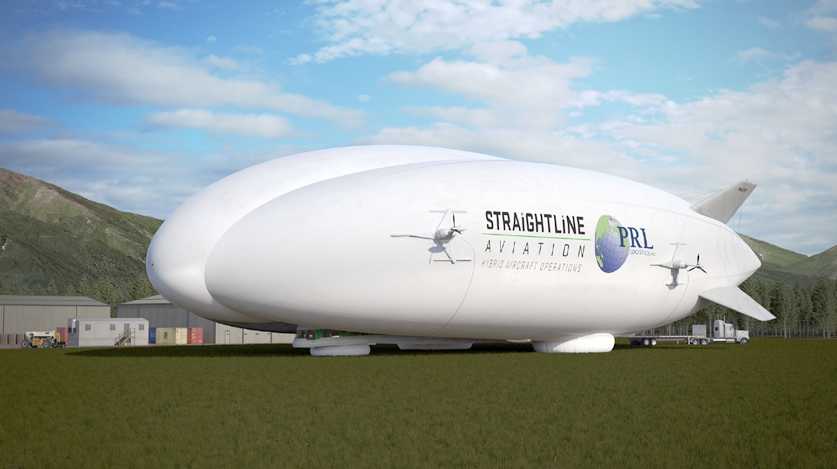KENAI — By 2019, people looking south across Kenai’s river flats or standing on its beach might occasionally see a giant, three-lobed ovoid rise into the air across the river and fly away.
This new aircraft will be a Lockheed Martin LMH-1 lifting off from the Kenai base of PRL Logistics, a transportation and support services company that announced Monday it had contracted to use the aircraft as a heavy transport to Alaska’s many construction sites far from the infrastructure of roads or airports.
“The goal here with this aircraft is to create an opportunity for companies to do projects they may not have been able to do because of the expense of logistics, infrastructure and current transportation methods,” said PRL president and CEO Ron Hyde. “We hope it will be something that can bring business to Alaska, that can help projects that don’t have deep pockets get into some remote areas.”
Though it resembles one, the 300-foot long LMH-1 — a recently designed aircraft set to go into production soon — isn’t a lighter-than-air blimp or dirigible. Nor is it a conventional aerodyne craft like an airplane or helicopter, but a hybrid of the two — 80 percent of its lift is generated by its helium-filled envelope, but the rest comes from the forward motion of its aerodynamic shape, propelled by four rotors and three belly-mounted hovercraft engines that will give it the thrust for a vertical liftoff.
PRL will use LMH-1s under a partnership with Straightline Aviation, a UK-based company that became the first purchaser of the LHM-1, buying 12 ships from Lockheed Martin in March 2016 for $480 million. Hyde said PRL will use all 12, possibly assigning the others to jobs in Canada, Africa and the Middle East. The Kenai-based craft, though, will be the first in operation.
“Alaska’s the first place we’re going to go,” Hyde said.
PRL will base the LMH-1 at its approximately 60-acre Logistics Operations Center on the south bank of the Kenai River, where it presently has a boat dock, helipad, command center and lodge. A large hangar for the new aircraft will be added to the site, Hyde said.
The hybrid aircraft’s payload capacity is slightly greater than the C-130 Hercules, the venerable heavy transport plane that’s already a common sight at the Kenai Airport. The LMH-1 can carry 47,000 pounds of cargo to the C-130’s 44,500 pounds, in addition to having an airliner-like cabin for 18 passengers.
One of the aircraft’s most important capabilities is its vertical takeoff and landing. Run in reverse, the hovercraft engines also play the role of landing gear by suctioning the aircraft to the ground. According to a press release from PRL and Straightline Aviation, it can land on snow, ice, gravel and water.
“This aircraft will be able to take Herc-sized loads into an area with no runway,” Hyde said. “It can be used for oil exploration or mining exploration or reaching remote villages in a disaster-relief situation, or remote construction projects, military projects that may be needed, or enhancing or cleaning up old military sites.”
In addition, Hyde said operating the LMH-1 was “much, much less expensive” than operating a C-130 because it consumes less fuel.
“From an emissions or carbon standpoint, it’s much more environmentally friendly source of transportation,” Hyde said.
Hyde emphasized that the LMH-1 won’t make the C-130 — or any of the other aircraft, barges, or other vehicles PRL uses — obsolete. For fast-moving projects with a suitably long runway nearby, the C-130 may still be a better transport option. The C-130’s top speed of about 368 miles per hour is far greater than the LMH-1’s top speed of about 69 miles per hour.
Basing the aircraft in Kenai may create new infrastructure needs for PRL, including gathering and storing helium to inflate the aircraft’s envelope.
“We’ll have a fair amount of helium we’ll stockpile on site,” Hyde said. “…I know our contracting department is working with the aircraft technical team to look into how to source that. Anything we can source in-state, we’re going to.”
Though helium is sometimes produced as a byproduct of natural gas extraction — especially in gas fields in Oklahoma, Texas, and Kansas — a 2004 Bureau of Land Management Report on U.S helium resources identified no known sources in Alaska.
Lockheed Martin’s assembly lines have yet to roll out a commercial model of the LMH-1, but Hyde said PRL’s agreement with Straightline Aviation is solid, as is the craft itself.
“I’ve been to the production facility and put my hands on one that has flown already, and it’s already gone through all the test flights,” Hyde said. “I’ve been in the fuselage.”
According to the PRL and Straightline Aviation press release, the Kenai-based LMH-1 is expected to arrive in 2019.
• Ben Boettger is a reporter for the Kenai Peninsula Clarion. Contact himat ben.boettger@peninsulaclarion.com.

